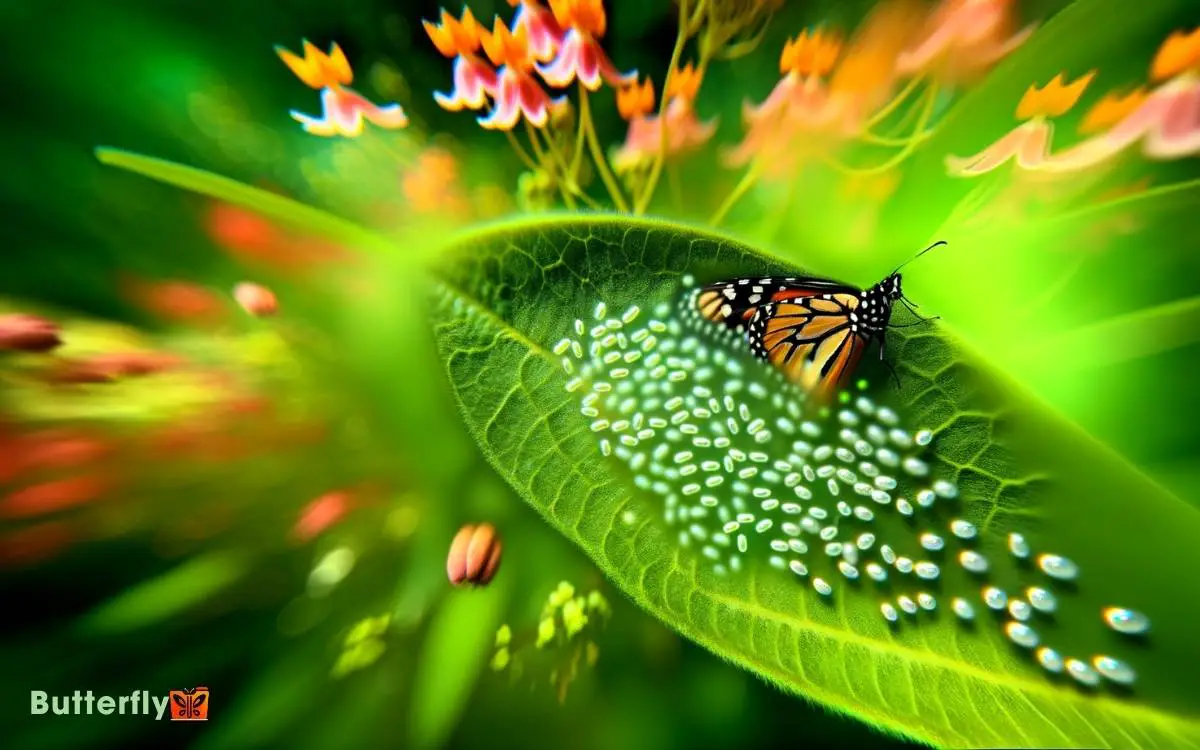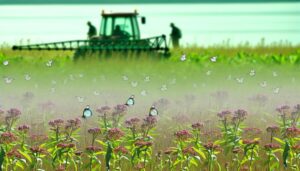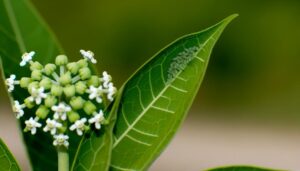How Many Eggs Can a Monarch Butterfly Lay? Find Out Here!
You’ll be amazed to know that a Monarch butterfly can lay between 300 and 500 eggs within its 2 to 6-week lifespan.
Females carefully select milkweed plants to deposit their eggs, ensuring ideal protection and nutrients for the larvae.
Egg-laying is strategic, with eggs placed on the underside of leaves to maximize survival chances. Factors such as host plant availability, environmental conditions, and the butterfly’s health greatly influence the egg count.
Understanding these intricate processes and conditions offers deeper insights into Monarch reproductive strategies and overall population dynamics.

Key Takeaways
Monarch Reproduction Overview
Monarch butterflies, renowned for their intricate life cycles, undergo a multi-stage reproductive process that’s both fascinating and complex.
You’ll find that it begins with mating, typically occurring on milkweed plants. Males transfer spermatophores, which are packets of sperm and nutrients, to females, ensuring genetic material’s successful delivery.
Females then store this sperm in a specialized organ called the spermatheca, allowing fertilization to occur even days later.
This internal fertilization mechanism maximizes reproductive success by enabling females to lay fertilized eggs over an extended period.
Understanding these reproductive intricacies highlights how monarchs adapt to their environments, ensuring the continuation of their species despite numerous ecological challenges. This multi-stage process is a reflection of their evolutionary sophistication.
Egg-Laying Process
Female monarch butterflies carefully select milkweed plants as the optimal sites for depositing their eggs, ensuring their larvae have immediate access to essential nutrients upon hatching. You’ll notice that this choice isn’t arbitrary.
Milkweed contains cardiac glycosides, which are vital for the larvae’s development and provide them with a defense mechanism against predators. The females use their tarsi to ‘taste’ the plant, confirming its suitability before laying eggs.
Each egg is meticulously placed on the underside of a leaf to protect it from environmental hazards and predators. This strategic placement maximizes survival rates, demonstrating a highly evolved reproductive strategy.
Average Egg Count
Understanding the meticulous egg-laying process leads us to the question of how many eggs a single female can produce during her lifetime.
On average, a monarch butterfly lays between 300 and 500 eggs. This range is based on observational studies and detailed data collection.
Each egg is carefully deposited on the underside of milkweed leaves, ensuring ideal conditions for larval development.
You’ll find that the female strategically spaces out her eggs to maximize the survival rate of the offspring. The significant variation in egg count stems from differences in individual health and environmental conditions.
Factors Affecting Egg Count
You’ll find that host plant availability greatly impacts a monarch butterfly’s egg count, as females lay eggs on specific milkweed plants.
Environmental conditions like temperature and humidity also play important roles, affecting both the butterfly’s physiology and the survival rate of eggs.
Additionally, a butterfly’s health status, including age and exposure to toxins, can limit its reproductive capacity.
Host Plant Availability
The availability of milkweed, the sole host plant for monarch butterfly larvae, directly influences the number of eggs a female can lay. You’ll find that a high density of milkweed plants correlates with increased egg deposition.
Studies show that females prioritize areas with abundant milkweed to optimize larval survival rates. When milkweed is scarce, females distribute their eggs more sparsely, reducing the total count.
Research indicates that habitat fragmentation and agricultural practices reducing milkweed availability can have a substantial impact on egg-laying behavior.
Environmental Conditions
Environmental conditions play an essential role in determining the number of eggs a monarch butterfly can lay. Temperature, humidity, and weather patterns play a vital role in influencing egg-laying behavior.
Ideal temperatures for monarchs range between 25°C to 30°C (77°F to 86°F). Deviations from this range can reduce egg production. High humidity levels are also advantageous, as they prevent desiccation of eggs.
Conversely, extreme weather events like storms or droughts can disrupt reproductive activities and decrease egg counts.
Additionally, seasonal changes impact milkweed availability, the primary host plant for laying eggs. In unfavorable conditions, monarchs may migrate to more suitable environments, but this often results in fewer eggs.
Monitoring these environmental factors is essential for understanding and supporting monarch populations.
Butterfly Health Status
A monarch butterfly’s health greatly impacts its egg-laying capacity. Factors such as disease, parasite load, and nutritional status play crucial roles in this process.
When a butterfly contracts diseases like OE (Ophryocystis elektroscirrha), its ability to lay eggs diminishes greatly. High parasite loads, particularly from tachinid flies, can also drastically reduce reproductive output.
Nutritional status is another essential factor; monarchs need access to nectar-rich flowers to maintain energy reserves. A well-nourished butterfly will generally produce more eggs.
Studies show that butterflies feeding on pesticide-contaminated plants often lay fewer eggs due to toxicity.
Therefore, maintaining good health through disease management, parasite control, and proper nutrition is crucial for maximizing egg-laying potential in monarch butterflies.
Lifespan and Egg Laying
Monarch butterflies live for about two to six weeks during their breeding season, during which time a female can lay between 300 to 500 eggs. This significant egg-laying ensures species survival despite high predation and environmental threats.
You’ll find that females deposit eggs singly on milkweed leaves, leveraging this host plant’s chemical defenses to deter herbivores.
Each egg takes 3-5 days to hatch, contributing to the rapid population turnover. The sheer volume of eggs laid compensates for the losses due to predation, disease, and other factors.
Understanding this cycle is vital for conservation efforts, as it highlights the importance of supporting milkweed habitats. By doing so, you help sustain the lifecycle of these remarkable pollinators.
Ideal Conditions for Laying
To maximize egg-laying success, female monarch butterflies seek out milkweed plants in areas with ideal sunlight, moderate temperatures, and minimal pesticide exposure. These conditions ensure the highest survival rates for their eggs.
- Sunlight is crucial as it helps maintain the warmth needed for the eggs to develop properly.
- Moderate temperatures prevent stress on both the female and the eggs, fostering optimal development.
- Minimal pesticide exposure is essential as it reduces mortality rates and promotes healthy growth.
Host Plants Importance
Host plants, particularly milkweed species, are critical for monarch butterflies as they provide the sole food source for their larvae and play a pivotal role in their reproductive cycle.
Without milkweed, monarchs can’t lay eggs effectively, leading to population declines. Studies show that female monarchs prefer to lay eggs on specific milkweed species due to their nutritional content and chemical defenses.
Here’s a quick comparison of three common milkweed species:
| Milkweed Species | Nutritional Value | Larvae Survival Rate |
|---|---|---|
| Common Milkweed | Moderate | High |
| Swamp Milkweed | High | Moderate |
| Butterfly Weed | Low | Low |
Seasonal Variations
You’ll notice that monarch butterflies exhibit distinct reproductive patterns depending on the season. During spring, they lay a higher number of eggs as they migrate northward, capitalizing on the abundance of milkweed.
Conversely, in the fall, their egg-laying decreases as they prepare for migration to overwintering sites.
Spring Egg Laying
As spring arrives, monarch butterflies initiate their egg-laying process, influenced by increasing temperatures and the availability of milkweed plants.
You’ll notice that these factors play critical roles:
- Temperature Rise: Warmer weather triggers reproductive behaviors.
- Milkweed Availability: Essential for larvae survival, milkweed is where females lay eggs.
- Photoperiod Lengthening: Increasing daylight hours stimulate hormonal changes in monarchs.
During this period, female monarchs can lay up to 400 eggs over two to five weeks. Best conditions ensure higher egg survival rates, with milkweed abundance directly impacting egg distribution.
Understanding these spring dynamics allows for better conservation efforts, aiding in the maintenance of monarch populations. By ensuring milkweed presence, you support this crucial phase in their lifecycle.
Fall Reproductive Patterns
In contrast to their prolific spring egg-laying, monarch butterflies exhibit markedly different reproductive behaviors in the fall, influenced by migratory imperatives and changing environmental conditions.
During this period, you’ll notice that monarchs enter a state called diapause, where they suspend reproductive activities.
This physiological shift is triggered by shorter daylight hours and cooler temperatures, preparing them for their long migration to Mexico. Instead of laying eggs, they focus on conserving energy for the journey.
Studies show that reproductive diapause greatly reduces the number of eggs laid in the fall, often to zero.
Understanding these seasonal variations underscores the monarch’s adaptive strategies for survival, ensuring their population can rebound in ideal conditions during the spring.
Geographic Differences
Considering geographic differences, monarch butterflies in warmer climates tend to lay more eggs due to extended breeding seasons.
You’ll find that regions with mild winters and prolonged warm periods support multiple generations of monarchs, increasing their reproductive output.
Conversely, in cooler climates, the breeding season is shorter, limiting the number of eggs laid.
Key factors influencing egg-laying rates include:
- Temperature: Warmer temperatures accelerate development and increase reproductive cycles.
- Availability of Milkweed: Abundant milkweed in warmer regions provides ample opportunities for egg-laying.
- Day Length: Longer days in warmer climates promote extended periods of activity and breeding.
Understanding these geographic differences helps in predicting monarch population dynamics and devising conservation strategies.
By recognizing how climate and environment impact reproductive rates, you can better support monarch butterfly populations.
Predators and Risks
While understanding geographic differences is essential, it’s equally important to take into account the predators and risks that monarch butterflies face throughout their lifecycle.
Monarch eggs, larvae, and adult butterflies are preyed upon by various species. Predators include spiders, ants, and wasps, which have a substantial impact on egg and larval survival rates.
Birds like orioles and grosbeaks are also known to feed on adult monarchs, despite their toxic cardenolides.
Additionally, parasitic flies and wasps lay their eggs in monarch larvae, leading to mortality. Pesticide exposure remains a significant threat, reducing population numbers.
Habitat loss exacerbates these dangers, limiting milkweed availability, which is essential for egg-laying and larval development. Understanding these threats helps in developing effective conservation strategies.
Impact of Climate Change
Climate change has a significant impact on monarch butterflies, affecting their migratory patterns, breeding cycles, and survival rates. Rising temperatures and erratic weather patterns disrupt the delicate balance required for monarchs to thrive.
This disruption is evident in several ways:
- Altered Migration Routes: Warmer climates shift the timing and routes of migration, causing disorientation and increased mortality.
- Breeding Challenges: Unpredictable weather impacts milkweed availability, the sole plant where females lay eggs, leading to lower reproduction rates.
- Habitat Loss: Extreme weather events and changing climates destroy critical habitats, reducing the areas where monarchs can safely breed and feed.
These factors cumulatively stress monarch populations, making it harder for them to sustain their numbers. Understanding these impacts is essential for anticipating future trends in monarch butterfly populations.
Conservation Efforts
To counteract the detrimental effects of climate change on monarch butterflies, targeted conservation efforts have become increasingly essential.
Habitat restoration plays a significant role, focusing on re-establishing milkweed plants, the sole food source for monarch larvae. By planting native milkweed and nectar plants, you can directly support monarch breeding and survival.
Additionally, reducing pesticide use helps create safer environments for these insects.
Monitoring programs, like tagging butterflies, provide valuable data on migration patterns and population health, informing further conservation strategies.
Collaborating with local organizations and participating in citizen science projects enhances conservation impact.
These targeted actions, backed by scientific research, are essential in mitigating the adverse effects climate change imposes on monarch populations.
Supporting Monarch Populations
Effective support for monarch populations hinges on providing ample milkweed and nectar sources within their migratory paths. By focusing on habitat restoration, you can make a significant impact.
Planting native milkweed species is essential as it serves as the sole host for monarch larvae. Additionally, guarantee a variety of nectar-rich flowers for adult butterflies.
Here are three effective strategies:
- Plant diverse native flora: Select milkweed and nectar plants suited to your region.
- Reduce pesticide use: Pesticides can harm both caterpillars and adult butterflies.
- Create waystations: Establish small habitats throughout migratory routes to offer rest and nourishment.
Conclusion
You’ll find it fascinating that, by sheer coincidence, the monarch butterfly‘s ability to lay between 300-500 eggs is intricately linked to the health of our ecosystems.
With climate change threatening habitats and predators ever-present, it’s essential to support conservation efforts.
By planting milkweed and reducing pesticide use, you’re directly contributing to their survival. So, when you see a monarch flutter by, remember: your actions are part of a larger, delicate balance.






